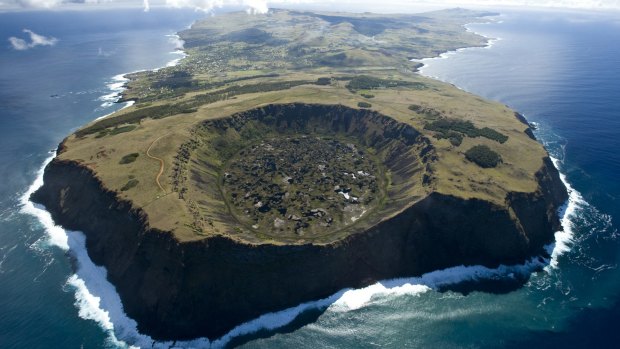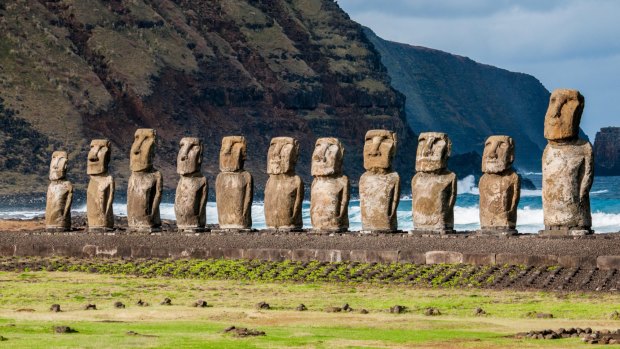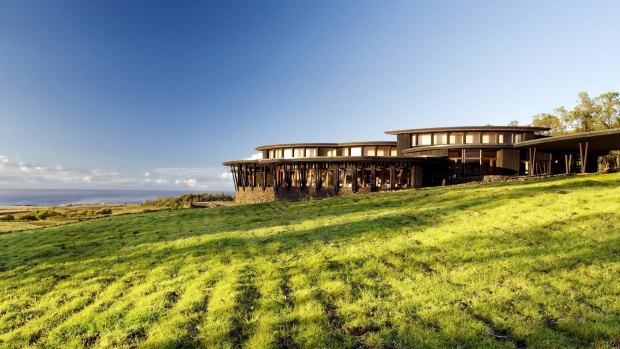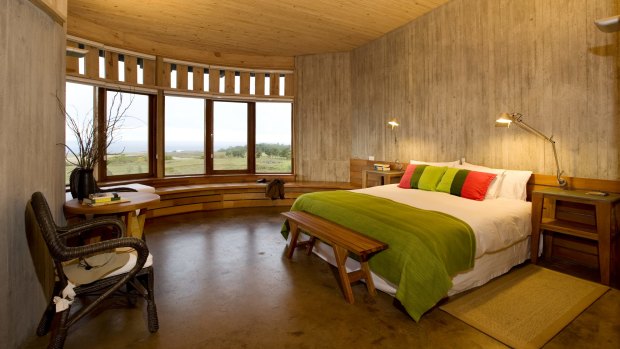This was published 7 years ago
Easter Island statues: Visiting the stone giants of Tongariki
By Isobel King

Volcanic crater, Rapa Nui.Credit: Explora
It's 8am and in the pitch-black before dawn, I'm scootering around desolate roads, dodging giant potholes and keeping a watchful eye out for the shadowy figures of horses that roam freely around Easter Island. There's about 10,000 of them, which is an alarming lot of horses for an island that measures about 25 kilometres at its longest point, and has a resident population of just 8000.
Cold and fatigued from concentration, I'm nearly ready to give up when I round a bend and suddenly spot them on the coastline: 15 towering silhouettes, standing like black giants against a streaky grey sky. It's a breathtaking sight. Their backs to the ocean, mounted on the traditional stone ahu platform, these solemn moai appear like the spiritual guardians of the island that legend would have us believe. Minutes later, I'm jostling with dozens of tripods and camera-wielding tourists, all here to witness the stone giants of Tongariki emerge out of the darkness and into the russet colours of dawn. It's a spectacle well worth the pilgrimage.
The 15 moai are among about 900 on Rapa Nui – and by far the most imposing, to my mind. The ahu isn't roped off, so you can get close to the 100-metre long platform and gaze up at the moais' broad, brooding features. All the statues are intact, and quite distinct, including one that bears a hat-shaped pukao, or topknot, which were carved from red volcanic stone, called scoria, and added separately.

Spiritual guardians: Moai statues on Easter Island.Credit: Alamy
However, the 15 moai didn't always look this refined. Like all the ahu on the island, the moai were toppled from their platform during the tribal wars of the 17th century. Then a tsunami hit in 1960, scattering the fallen moai even further. It took a mammoth restoration project in the 1990s to get them back on stage. At the entrance to Tongariki, you can see a picture of a crane hefting one of the giant moai back into place. It begs the question: how did the Rapa Nui people transport and erect these colossal monoliths in the absence of wheels or draft animals, yet alone a crane?
Undisputed is that the nearby quarry on the grassy flanks of the extinct Rano Raraku volcano is where nearly all the island's 887 statues were carved from volcanic stone. Around half of them are still here, some buried up to their torso and dotting the desolate slopes that overlook Tongariki and the spectacular ocean vista all around. It feels, quite literally, like the bedrock of ancient Rapa Nui civilisation.
What scholars can't agree on is exactly how these statues, which average about four metres high and weigh around 12 tonnes, were transported to virtually every corner of the island.

Explora, exterior.Credit: Explora
The Rapa Nui have a simple explanation, passed down through generations: the moai walked, powered by the spiritual force of mana. Successive scientists have tested out more earthly theories, including strapping replicas to tree trunks and dragging them along the ground, and rolling them on sleds over log rollers. Those theories would certainly neatly explain how the island was stripped of its palm trees.
However, the prevailing theory is that the statues indeed walked, but propelled by manpower and ropes and a simple side-to-side rocking motion on their bases. I've watched the video of the field experiment done by archaeologists Terry Hunt and Carl Lipo to support their 2011 ground-breaking book, The Statues that Walked: Unravelling the Mystery of Easter Island – which I also had a chance to browse through back at the library of my luxury digs, Explora.
It's an ingeniously simple, but mighty compelling, hypothesis that required surprisingly little manpower. Comparing the statues in the quarry to those at the ahu, they found the bases were moulded for easy "rocking" and edged along specially constructed roads – you can still see the vague outline of the roads via satellite imagery; the bases were later refined in situ to sit on the ahu. With no written and scant oral history to rely on, we'll never know for sure, but it's a theory that certainly marries probability with legend.

Explora bedroom.Credit: Explora
GETTING THERE
LAN Airlines operates daily flights between Sydney and Santiago via Auckland. There are flights to Easter Island from Santiago every day except Tuesday. Australian citizens pay a reciprocity fee of US$117 on arrival in Santiago; see latam.com
STAYING THERE
The Explora Hotel Posada de Mike Rapu Easter Island is an all-inclusive, 30-room hotel (all meals and beverages and daily excursions with bilingual guides are included). Three-night packages from $2538 per person, twin-share; see explora.com
GETTING AROUND
Explora includes free transport to attractions. In town, you can rent scooters from about 25,000CLP a day (motorcycle licence required); cars start from around 45,000CLP. See rentainsular.cl
Isobel King travelled courtesy of South America Tourism Office and LATAM Airlines.
Sign up for the Traveller Deals newsletter
Get exclusive travel deals delivered straight to your inbox. Sign up now.